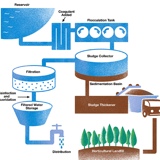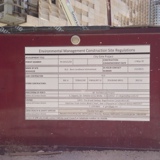Audit Scope
Audit
-
Conducted on
-
COR:
-
Workgroup Audited:
-
Site name/Code:
-
Location
-
Project No./Name:
-
Audit Team:
Audit Scope
Audit Objective
-
The objective of this fixed site audit is to ensure Gippsland Water has procedures and systems in place to actively manage the environmental risks associated with activities undertaken on-site. When working on any site Gippsland Water's Environmental Management System (ISO14001), Gippsland Water's environmental policies, procedures, and all legal and other requirements (i.e. permit conditions, legislation) must be adhered to. The audit team has the right to issue non-conformances (NC), system improvements (SI) and/or observations (see Evaluation of Compliance Criteria for definitions) to the Responsible Officer (RO) of the project depending on the nature of the findings.
Evaluation Criteria
Observation
-
an issue that can improve the operations of the EMS and that if left unaddressed is likely to lead to a non-conformance during future audits;
an example of good environmental practice that deserves recognition; or
a flag or re-visit at the next audit.
System Improvement
-
an identified improvement in Gippsland Water's EMS procedures.
Non-conformance
-
a non-fulfilment of a requirement, whether that of an EMS procedure(s), or the ISO 14001:2004 standard.
Audit Instructions
-
1. All members of the audit team are to complete a copy of the checklist below, however only one copy of the audit report needs to be completed per audit.
2. This checklist is designed to be used in conjunction with the EPA Bundling Guidelines.
3. Auditors are encouraged to use photographic evidence to supplement other notes where possible.
4. All sections of this checklist are to be completed. Any field nominated as Not Applicable (N/A) must be justified.
5. Additional copies of this checklist can be found at COR/13/6544.
6. All copies of this checklist and report are to be saved into TRIM (the location specific to each workgroup, seek clarification with the workgroup manager).
7. Please ensure all audit document titles clearly identify the date and site at which the audit was completed.
8. Once finalised with photographs and signatures (PDF format), the TRIM reference for all final reports is to be sent to the Environment Team for inclusion in the EMS Action Plan.
Audit Checklist
Audit Checklist
-
Note: If there are additional works on-site (i.e. construction activities) please complete the Construction & Earthworks Internal Environmental Audit Template (COR/13/13589) in addition to this template (i.e. two checklists may be required to complete the audit)
Noise
-
Have there been any recent noise complaints?<br>If so, how we're these documented (e.g. ConnX, Hansen; please include TRIM reference or Workorder No.).
-
Are there higher than normal noise levels on-site (i.e. can anything be heard beyond the premises boundary)?
-
If yes above, controls are in place to reduce noise exposure or nuisance to neighbours?
-
Comments:
-
Add media
Flora & Fauna (inc. weed management)
-
Is there any significant native vegetation (tress, grasses, shrubs) on-site? If so, please provide a basic description (number, area, age, size, etc) or take a photograph.
-
Are there any management plans for the native vegetation on-site and if so, are the requirements being adhered to?
-
Are pest plants and animals being managed accordingly within the property (e.g. any evidence of infestations)
-
Who undertakes these activities?
-
Are there any noxious weeds within the site boundary (e.g. Blackberries, Scotch Thistle, Ragwort)?
-
Is there any vegetation proposed to be removed or cleared for works in the future?
-
If so, has the Environment Group been notified and completed an Environmental Impact Assessment? <br><br>If no, please provide photographs of the vegetation and a description of the proposed works.
-
Image of vegetation to be removed:
-
Description of the works (incl. area of total disturbance):
-
Is there any evidence of native flora or fauna in the area being removed or impacted recently?
-
If so, have the necessary permits and requirements been adhered to, was the Environment Group notified of the works?
-
Comments:
-
Add media
Cultural Heritage & Heritage
-
Has there been any significant ground disturbance on-site?
-
Has there been any evidence of aboriginal artefacts?
-
Is there any evidence of buildings, plant, vegetation etc. of heritage significance on-site?
-
If yes, what management controls have been implemented to protect these items or significance?
-
Comments:
-
Add media
Air Quality (emissions, air, dust, odour, GHG)
-
Is there any abnormal emissions being caused by the operational or maintenance activities?
-
Is there any visible dust plumes, smoke or other visible emissions?
-
Have there been any recent complaints from the public about odour on-site?
-
If so, how was this complaint dealt with and recorded (e.g. ConnX, Hansen, etc.)?
-
Can you detect any odour on-site? If so, can you detect it beyond the site boundary?
-
Is the operator aware of how to report an odour complaint received from the public?
-
Comments:
-
Add media
Water Quality and Management
-
Is there a waterway or wetland (excluding operational lagoons) within the premises boundary?
-
If so, are these fenced off or otherwise e protected?
-
Do close by water bodies have any evidence of contamination?
-
Is there a weir, extraction point or discharge point on-site, or supplementary to the site?
-
If so, is there any evidence of oil, scum, litter or other objectionable matter in the surface water at this point?
-
Is the extraction point or discharged point clearly labelled?
-
Are surface water drains on-site clear of debris and showing no signs of damage?
-
Does the site operator know the location of drainage on-site and where these drain to?
-
Are there, or have there been any recent algae blooms in lagoons, discharge or extraction points?
-
Have there been any recent exceedences of EPA, SDWA or other water quality guidelines?
-
Are there any leaking taps (fuel, water, etc) plant or equipment on-site?
-
Comments:
-
Add media
Sediment & Erosion Control
-
Is there evidence of erosion (i.e. at the discharge point, extraction point or weir)?
-
If so, please take an image of this
-
Is there evidence of any damage to the banks of any waterways present on-site (e.g. livestock access, tracks, flood damage)?
-
If so, please take an image of this
-
Comments:
-
Add media
Waste & Resource Use
-
Are recycling and waste options available?
-
Is there any hazardous waste created on-site (e.g. asbestos, sludge)?
-
If so, is there suitable waste disposal options/management on-site?
-
Are there any materials or waste products created on-site that could be more appropriately disposed of, reused, recycled?
-
Comment:
-
Is there any evidence of litter, scum, oil or other objectionable matter on land?
-
Comments:
-
Add media
Chemical Storage & Usage
-
Are storage areas secure to prevent unauthorised access or vandalism?
-
Are spill kits available on-site?
-
Are all chemical filling points bunded?
-
If not, please take a photograph
-
Does chemical and fuel bunding meet EPA guidelines?
-
Comments:
-
Add media
Contaminated Material (CASS, PASS, Landfill)
-
Are there contaminated materials on-site? If so, are they being managed accordingly?
-
Are contaminated materials being transported and reported accordingly?
-
Comments:
-
Add media
Environmental Emergency Management
-
Is a copy of the Crisis Management Plan available on-site and current?
-
Is a copy of the Site Emergency Plan available on-site and current?
-
Have any environmental incidents occurred on-site?
-
Details of incident:
-
If so, was the operator aware of how to report incidents or opportunities for improvements?
-
If so, was it recorded properly?
-
Comments:
-
Add media
Monitoring & Measurement
-
Has all lab equipment been calibrated within the specific timeframe (i.e. by the due date) or within the six months?
-
Has the operator received training on sampling timeframe (i.e. by the due date) or within six months?
-
Are all sampling points for water, soil and air monitoring clearly marked and accessible?
-
Does the sampling point require any maintenance or modification?
-
Are all checklists, daily readings etc. stored in TRIM?
-
If not, why?
-
Comments:
-
Add media
Audit Report
Audit Report
1
-
-
Finding:
-
Evidence:
-
Action:
-
Responsible Manager:
-
Due Date:
2
-
-
Finding:
-
Evidence:
-
Action:
-
Responsible Manager:
-
Due Date:
3
-
-
Finding:
-
Evidence:
-
Action:
-
Responsible Manager:
-
Due Date:
4
-
-
Finding:
-
Evidence:
-
Action:
-
Responsible Manager:
-
Due Date:
5
-
-
Finding:
-
Evidence:
-
Action:
-
Responsible Manager:
-
Due Date:
6
-
-
Finding:
-
Evidence:
-
Action:
-
Responsible Manager:
-
Due Date:
7
-
-
Finding:
-
Evidence:
-
Action:
-
Responsible Manager:
-
Due Date:
8
-
-
Finding:
-
Evidence:
-
Action:
-
Responsible Manager:
-
Due Date:
9
-
-
Finding:
-
Evidence:
-
Action:
-
Responsible Manager:
-
Due Date:
10
-
-
Finding:
-
Evidence:
-
Action:
-
Responsible Manager:
-
Due Date:
11
-
-
Finding:
-
Evidence:
-
Action:
-
Responsible Manager:
-
Due Date:
12
-
-
Finding:
-
Evidence:
-
Action:
-
Responsible Manager:
-
Due Date:
Audit Report Approval
-
Workgroup Manager:
-
Select date
-
Manager Environment Team:
-
Select date
-
Lead Auditor:
-
Select date
-
Auditor:
-
Select date














